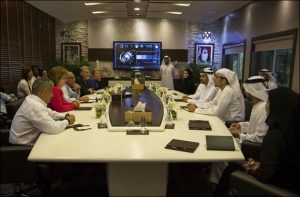
On 15 June 2016, NASA Administrator Charles Bolden visited the Mohammed bin Rashid Space Centre (MBRSC) accompanied by a number of NASA officials and representatives of the United States Embassy in the UAE and the United States Consulate in Dubai. Bolden and the accompanying delegation met with His Excellency Yousuf Hamad Al Shaibani, Director General of MBRSC, project managers and a number of officials.
The two parties discussed various issues related to the space sector, as well as the centre’s achievements in promoting the cultures of scientific innovation and technical development in Dubai and the UAE, and utilising space science and industry to support economic development in the country.
During the visit, MBRSC’s main projects were showcased, including the Emirates Mars Mission – Hope, and KhalifaSat. MBRSC also highlighted its strategic plans and future visions, aiming to support the UAE’s goal of playing a leading role in the space sector worldwide. Engineer Omran Sharaf, Project Manager of Emirates Mars Mission, presented the scientific goals of the project and the progress achieved so far, indicating that the Hope probe is the first of its kind, and will continuously study the Martian climate throughout the day and the changing seasons. Sharaf also shed light on the associated scientific and educational initiatives that contribute to building the next generation of national scientists and engineers.
Engineer Amer Al Sayegh, KhalifaSat Project Manager, then showcased the new innovations involved in KhalifaSat that will make it one of the most advanced in its category, due to its small size and lightweight structure, as well as its technology. Al Sayegh also shed light on the significance of the project as it contributes to promoting the sustainability of the satellite industry and space projects in the UAE, being the first satellite designed and manufactured entirely by Emirati nationals and expertise at the MBRSC’s Space Technology Laboratories in Dubai.
Bolden was also briefed on the MBRSC initiatives aimed at developing the space sector and promoting optimal investment in national manpower in the fields of advanced satellite manufacturing and space research, in addition to space technologies developed purely by Emirati engineers to utilise satellite images in research and studies, in the interest of various development projects in the UAE.
Afterwards, Bolden visited the MBRSC Space Technology Laboratories. He was also briefed on the working processes within the Ground Segment of DubaiSat-2, the Emirati satellite that provides high quality satellite images of 1-metre resolution, serving environmental projects, urban planning, infrastructure projects and scientific research.
“NASA is leading an ambitious journey to Mars, and we are glad to be formal partners with our colleagues in the UAE,” said NASA Administrator Charles Bolden. “Through these agreements we signed this week, we are enabling collaboration in projects to explore the Red Planet as well as cooperation in other areas of strategic focus for NASA. Like the NASA Mars rover Curiosity, the Emirati Mars Mission is serving to inspire a new generation of scientists and explorers in the UAE and around the world.”
Expressing his pleasure at Bolden’s visit, His Excellency Yousuf Hamad Al Shaibani, Director General of MBRSC, said: “This visit represents a great opportunity to showcase the Centre’s progress since the launch of the first satellite, as well as the UAE’s progress in the space industry, both of which have been achieved in a relatively short period of time. This emphasises the leading standing of the UAE today, being one of the most prominent space centres regionally and globally, with ambitious national projects in space research and the satellite industry.
“We are seeking to play a pivotal role in the global space industry by launching a series of leading initiatives focused on enriching human knowledge and serving humanity. In this regard, we decided to start our journey by developing the capabilities and skills of the Emirati team of experts and engineers, while establishing the infrastructure necessary for building a national space sector,” he added.
“In recent years, the space sector has witnessed fast progress in terms of space activities and technologies worldwide, and an increase in the strategic plans countries are developing in order to make the space industry one of the pillars of sustainable development plans. In this context, we believe in the importance of joint work and cooperation among countries and institutions for the development of space science and research to serve man and humanity on our planet,” Al Shaibani concluded.
 SpaceWatch.Global An independent perspective on space
SpaceWatch.Global An independent perspective on space

